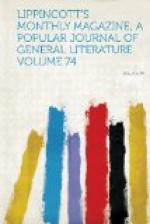To a few ladies and to the angiolini a special permission to enter the enclosure was given in honor of the day: a festive meal was served in the bare, cool refectory, the rule of silence being relaxed for the special occasion, and the nuns wearing a happy, child-like expression that hardly varied in the face of the youngest novice and that of the septuagenarian “mother.” The strangers were shown through the dormitories, the kitchen, the laundry, the garden, the community-room, where embroidery, painting and study diversify the labors of the broom and the dishcloth, and everywhere the same exquisite neatness struck the eye. Everything used in the house was of the coarsest description—the linen like sack-cloth, but speckless; the delf as thick and rough as if made for sailors; the floors mostly of brick or stone; the furniture of unpainted deal. Over each bed, which is only a board on trestles covered with heavy sacking, is a common crucifix and a sprig of box or olive blessed on Palm Sunday. The sisters sleep in their tunics. The library is common property, but no one may use or read any book save by permission of the superioress. The rules of fasting and abstinence are not exactly the same in every convent of the order, but the broad rule is that meat should be eaten only on great holidays, vegetables and farinaceous preparations, such as most Italians are not unskilled in, forming the staple of the nuns’ food. Fish is almost as rare a luxury as meat. Their bread is coarse and brown, and their drink indifferently water or a wine so sour that it is practically vinegar. Not that these nuns are not good cooks and bakers: witness the delicate sweetmeats, biscuits and pastry they offer to strangers on such festival days as the one just described, the fruit-preserves in blocks sold for




